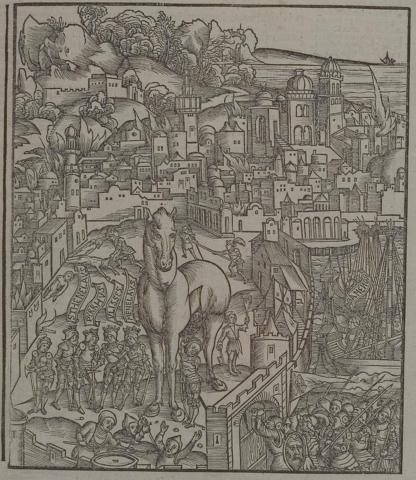Annotations
In this image, the Greeks begin their nighttime attack on Troy. In the middle right, the ships, led by Agamemnon, have made their way back to the Trojan shore from Tenedos (254-6). Sinon has unlatched the door to the wooden horse, and the warriors are climbing out (257-9). Among the warriors are Sthenelus [Sthenelaus], Neoptolemus [here called Pyrrhus], Ulisses, and Menelaus (261-64), some of the best warriors among all the Greeks. Behind the horse, some Greeks kill the watchmen (265), while more Greek soldiers wait at the gate to be let into the city (266-8). There are fires in many of the watch towers and tall buildings, an additional clue that the city is in distress, though Virgil has not yet mentioned fire. (Katy Purington)
Woodcut illustration from the “Strasbourg Vergil,” edited by Sebastian Brant: Publii Virgilii Maronis Opera cum quinque vulgatis commentariis expolitissimisque figuris atque imaginibus nuper per Sebastianum Brant superadditis (Strasbourg: Johannis Grieninger, 1502), fol. 166r, executed by an anonymous engraver under the direction of Brant.


Sebastian Brant (1458–1521) was a humanist scholar of many competencies. Trained in classics and law at the University of Basel, Brant later lectured in jurisprudence there and practiced law in his native city of Strasbourg. While his satirical poem Das Narrenschiff won him considerable standing as a writer, his role in the transmission of Virgil to the Renaissance was at least as important. In 1502 he and Strasbourg printer Johannes Grüninger produced a major edition of Virgil’s works, along with Donatus’ Life and the commentaries of Servius, Landino, and Calderini, with more than two hundred woodcut illustrations. (Annabel Patterson)